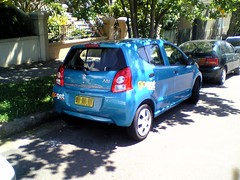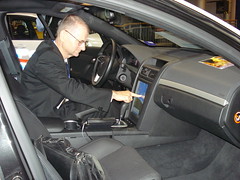
A report by the Victorian Government's
Chief Investigator, Transport and Marine Safety Investigations, on the "
Level crossing collision V/Line Passenger Train 8042 and a truck near Kerang" (5 June 2007), was released 15 February 2008 . The Victorian Minister for Public Transport, Lynne Kosky,
announced 22 July 2007 than two
red-light cameras would be trailed at level crossings and 200 crossings would have "rumble strips" installed. But by using advanced wireless technology and integrating the cameras into the red lights, it should be possible to get the cost of the far more effective red light cameras down to that of the rumble strips.
The two red light cameras were announced to cost $1.8 million, or $900,000 each, whereas the "rumble strips" were $11.7 million for 200, or about $59,000 each.
Rumble strips are simply lumps on the road to give the driver an auditory and physical warning that they are approaching a
level crossing. They do not warn of a train approaching and do not report a vehicle which fails to stop. This is far less effective than a set of lights and bells, activated by a
grade crossing predictor, which warn of a train or a camera which records a vehicle illegally crossing so a fine can be issued.
The difficulty with warning lights and cameras is the high cost of installation. Power has to be supplied to the crossing for the equipment. Detectors need to be fitted to the track to signal a train approaching and wires run to the signals. Underground cabling has to be used near the road to connect the equipment. Cameras with film have to be regularly checked to have their film changed.
However, the cost of this installation could be lowered by integrating the equipment, making it solar powered and connected by wireless. Solar powered detectors could be placed by the track where required and signal to the crossing of an approaching train. Each signals could be self contained on its own pole, simply planted in the ground. The red light camera and car detectors would similarly be on the same or other poles.
The equipment could be assembled and tested in a factory, so that there would be the minimum of work needed on site. After installation of the poles, the installation staff would simply switch on the equipment. The system could then be tested by the factory technicians via the wireless link. The installation staff would then walk and drive across the crossing while the remote technicians tested operation. In this way installation for simple crossings could be reduced from days, to less than an hour, with just two on site staff.
The wireless system would regularly check that each component was functioning by exchanging test signals. Failure of a component would be signaled to a maintenance depot. Digital photos of vehicles failing to stop at the crossing would be transmitted to the appropriate authority by wireless. Vehicles stopped on the crossing would be signaled to the railway operator, to warn oncoming trains. Similarly any collision at the crossing would be signaled to the emergency services.
To remove the need for wires, short range digital wireless signals would be used for communication between the local components of the system and long range wireless to the train control network. These signals could be encrypted and use other techniques to prevent deliberate or accidental interference. The equipment would be solar powered to eliminate connection cables. To lower the power and maintenance requirements, warning lights would be
LEDs.

To reduce installation costs, all the equipment would be installed on the poles, with no track side cabinets needed. An example of such a wireless pole mounted safety application is the Sydney CBD's
Emergency Warning and Intercommunication System (EWIS), by Sydney based company
Open Access.
In addition to detecting vehicle crossings against the lights, the system could also detect pedestrian and livestock crossing. While it would be infeasible to issue automatic fines to pedestrians, the system could issue an additional warning to the pedestrians via a synthetic speech or a recording: "train approaching; get off the track NOW!". They could also be used to assess where further safety measures were needed.
Components of such a system are already offered by various suppliers, such as the
ELSIE Level Crossing Protection System (Type ELS-6007) from Victorian based
GNS Associates Pty Ltd.
For the simplest level crossings it may be possible to install all the equipment for a warning system on just two poles: one on each side of the crossing. Detectors on each pole would sense oncoming trains, vehicles and pedestrians, signaling as appropriate.
One way to fund the development of such a system would be to discontinue the Victorian Government's
Don’t risk it! marketing campaign. Issuing of an educational CD-ROM for schools and public advertising would be ineffective in improving safety at level crossings, even if it contained dramatic footage, such as the
train smash video from
Top Gear.
Labels: Cars, Train, Transport, wireless internet access














